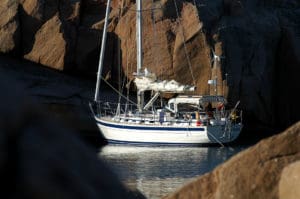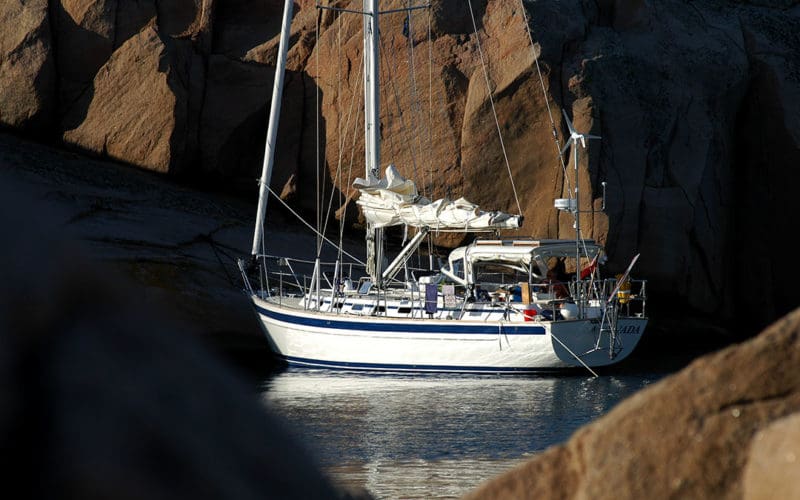
My wife Terrie and I built our first boat, an Ingrid 39 called Nada, in Louisiana, funded by a job in the Gulf of Mexico oilfields. A few years earlier Terrie and I were aboard my brother Chris’ boat — which was equipped with a hard-to-start Thorneycroft engine — when the boat was nearly sunk by a freighter in the English Channel. The image of that freighter bearing down on us, which had given me nightmares for years afterwards, was implanted in my brain. I was determined to have an engine that could be depended upon to start both electrically and by hand-cranking if the electrical system failed.
We installed a Sabb 2JZ engine in Nada. This was the last of generations of heavy, slow-revving fishing boat diesel engines that found their way onto pleasure boats. In 1978, when we bought ours, this style of engine had already been almost completely supplanted by lighter, higher-revving diesels coming out of the automotive world, but none of these engines could be hand cranked in an emergency.
The Sabb lived up to its reputation for absolute reliability. We put more than 5,000 hours on it without a hitch. It was over these years that I learned (the hard way) about boat electrical systems, culminating in the first edition of my Boatowner’s Mechanical and Electrical Manual. The corollary to getting on top of the electrical side of things was that I slowly lost my fear of an electrical systems failure. We were paying a heavy weight and space penalty for a hand crank feature that we never needed. The Sabb eventually came out to be replaced by a Yanmar. We’ve never looked back.
Impressive reliability
So long as it is properly installed and maintained, the modern diesel engine has proven to be an amazingly dependable piece of equipment. As a result, it has moved from being an auxiliary to center stage in terms of energy production, and not just for propulsion but also for the entire portfolio of house systems found on modern boats. The Volvo-Penta D2-75 in our current boat drives an 8kW alternator charging a substantial bank of lithium-ion batteries that enable us to live as comfortably on our boat as we do at home and to do this for months at a time without ever plugging into shore power. Fundamentally, the high standard of living on our boats that we now all take for granted rests on the reliability of modern diesels.
Over the past decade we have been moving into a new generation of diesel engines that are significantly different from all that have gone before. The changes are being driven by tougher emissions standards that have quite deliberately forced engine manufacturers, through the legislative process, into extraordinarily sophisticated, electronically controlled, high pressure common rail (HPCR) technologies.
Although at the present time most marine diesel engines below 100 hp still use conventional injection technology, within a few years it will most likely not be possible to buy a non-HPCR diesel engine. Yanmar, for example, has for several years now been using HPCR technology on almost all its engines. The HPCR engines bring with them improvements in efficiency and reliability in normal use, with smoother operation, especially at low speeds, and the elimination of the carbon-fouling that has bedeviled auxiliary sailboat use for decades, but also new vulnerabilities in terms of the electronics and injection systems.
As with most modern electronics, the electronic control units (ECUs) are extremely robust, but if anything fails an ECU is well beyond the competence of any sailor to troubleshoot. An example might be a lightning strike, which most conventional diesel engines would survive whereas ECU-equipped boats will be dead in the water with no possibility of resuscitating the engine. The ECUs are also wired to a substantial number of sensing devices monitoring all of the core systems on the engine. If any of these devices fail, or something as simple as a poor connection develops in the wiring harness or its plugs, the ECU may well shut down the engine. As batteries age, if the battery powering the ECU is also connected to high load devices such as a windlass or bow thruster, these high loads can momentarily drop the voltage down to levels at which the ECU shuts down the engine.
Fuel filtration all important
The ECU is also managing a fuel injection system that operates at unbelievably high pressures (up to 40,000 pounds per square inch), with components machined to incredibly fine tolerances (millionths of an inch). To protect these components, a level of fuel filtration and cleanliness is required that is significantly beyond what has been required in the past. Whereas with traditional fuel injection systems we have typically filtered diesel fuel down to seven to 10 microns (a micron is a millionth of a meter), the fuel for HPCR engines needs to be filtered down to two microns.
As an additional precaution against fuel contamination, for any diesel engine I recommend a mechanism to periodically pull a fuel sample from the base of the fuel tank. Given that most fuel tanks are installed below our engines, this typically requires a line led to the lowest point in the tank (I recommend within an eighth of an inch of the bottom) connected to a hand or electric pump discharging into a jam jar or similar vessel. I sample our tank after every layup, and shortly after refueling before cranking the engine, and periodically during an extended cruise.
Maintaining fuel cleanliness has always been important with diesel engines. It is now far and away the single most important aspect of routine maintenance. To avoid the potential for extremely expensive, engine-stopping damage, the fuel system must be fanatically maintained.
With a properly maintained electrical and fuel system, when that freighter is bearing down on you in the middle of the night, there will be no doubt about the ability to crank the engine and power out of the way.
Contributing editor Nigel Calder, the author of numerous marine books, voyages with his wife Terrie aboard their current boat Nada, a Malo 46.

